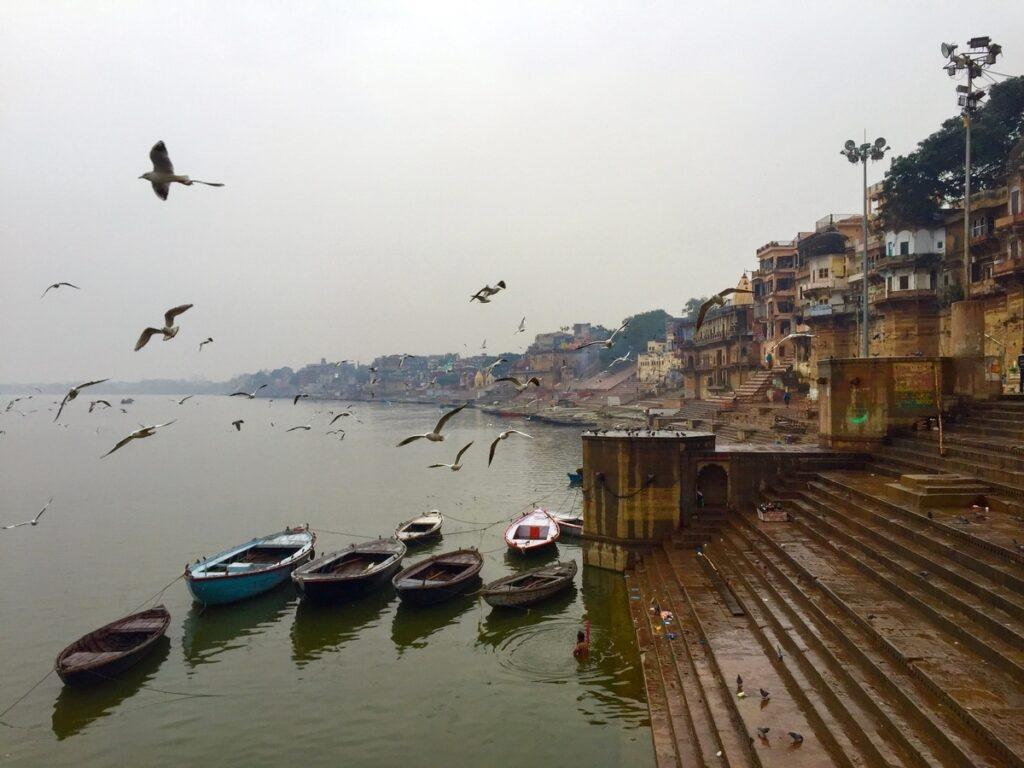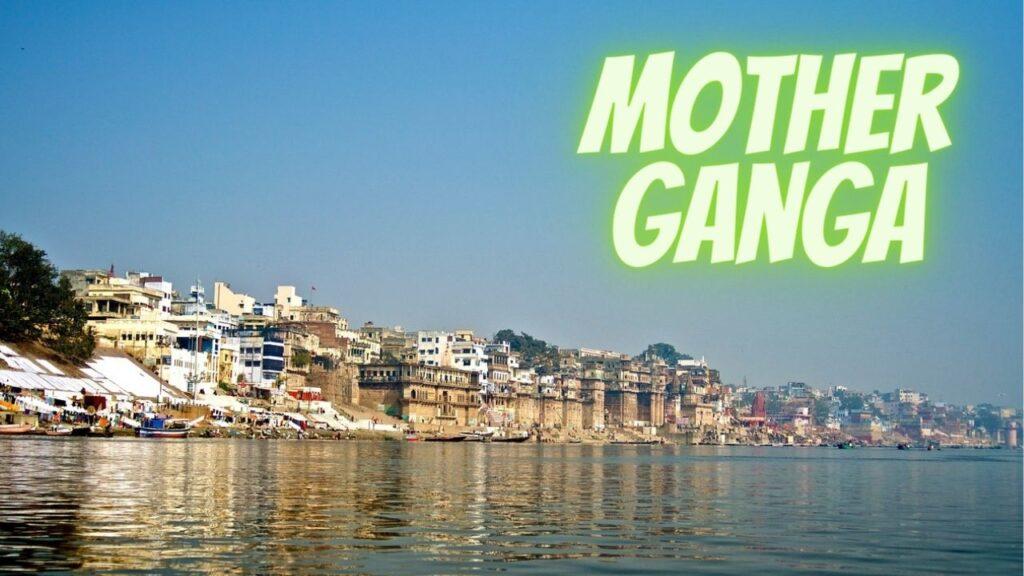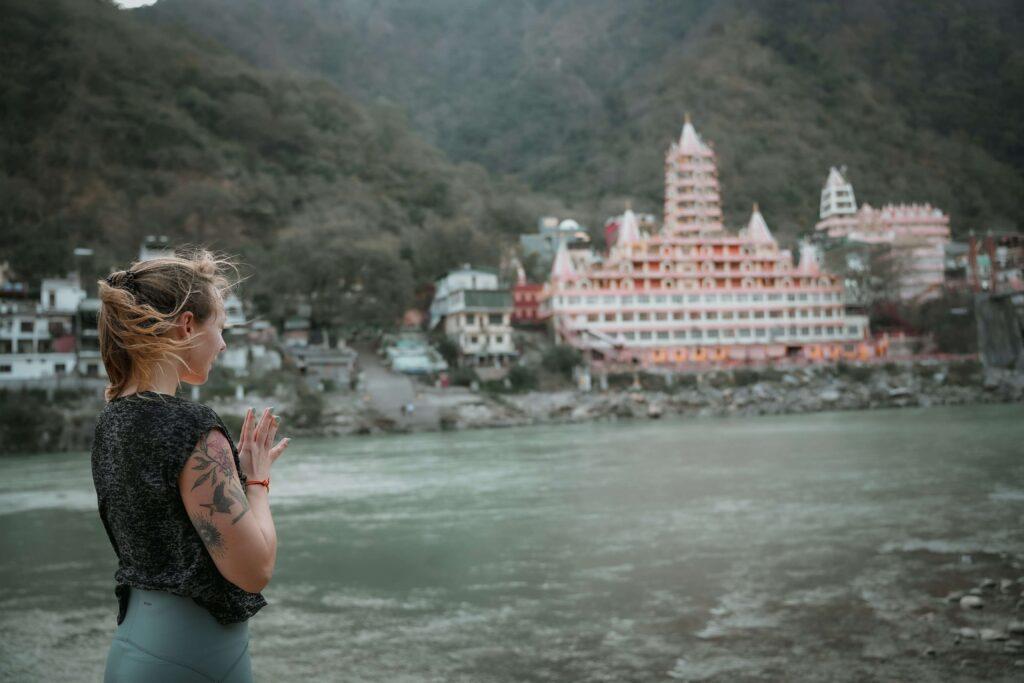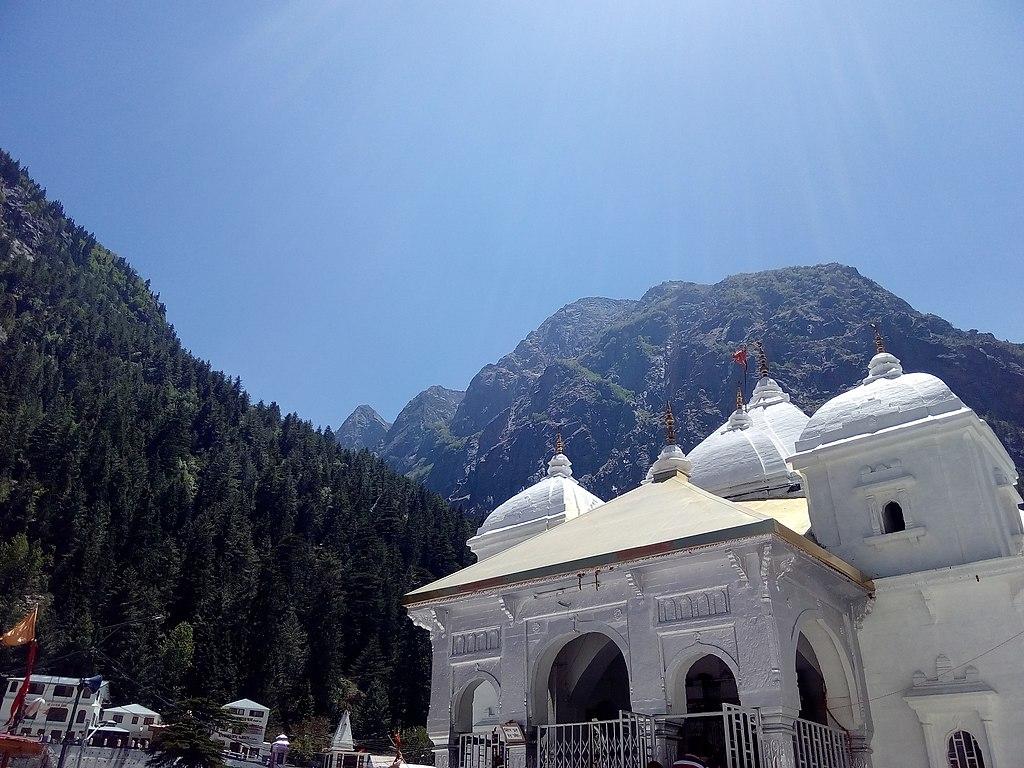
Mother Ganga, with her gentle flow originating from the sacred lotus feet of Krishna, the Supreme Lord, holds a hallowed status as the “patita pavani,” the celestial purifier of souls who have strayed from the righteous path. Ganga personifies not only purity but also boundless compassion. Her winding journey symbolizes a gracious cleansing, as she absolves the transgressions and impurities of those who yearn for spiritual redemption, providing them with a transformative route towards spiritual revitalization. The ancient scriptures, repositories of divine wisdom and profound teachings, eloquently illuminate the profound significance of Ganga as a purifying force. This article endeavors to narrate the captivating tale of her origin and the divine descent that brought her to the earthly realm, enriching our understanding of her divine grace.
Ganga – The Daughter of Himavan
In the distant north, the majestic Himalayas stand tall, often referred to as the “king of mountains,” presided over by Himavan, their divine guardian. Himavan and his consort, Mena, the daughter of the celestial Mount Meru, were blessed with two incredibly beautiful daughters. The elder daughter, Ganga, eventually transformed into the sacred river Ganges at the request of the gods. The younger daughter, Uma, also known as Parvati, was given in marriage to the immensely powerful deity Shiva, with whom she found joy in the realms of celestial bliss.

The gods, led by Brahma, approached Shiva, expressing concern about the consequences of his union with Uma. They asked him to retain his vital energy to prevent the world from being overwhelmed by their offspring’s brilliance. Shiva agreed but asked where his vital seed should go. Brahma suggested that it descend upon Earth, as she alone could withstand its potency and carry the burden of all beings.
Ganga gives birth to Karttikeya
Shiva released his seed, which covered the entire globe. Brahma instructed Agni, the god of fire, “With Vayu by your side, swiftly traverse the Earth and collect Shiva’s potent seed. The gods previously requested a mighty commander for their army. Let Ganga bear this seed, so that she may give birth to a radiant son who will lead the gods.”
Agni promptly gathered Shiva’s vital fluid and approached Ganga, saying, “Please accept Shiva’s seed, O Goddess!”
Ganga assumed an ethereal human form of extraordinary beauty. Upon encountering this form, Shiva’s seed liquefied, and the god of fire impregnated Ganga with its fiery essence.
Burning with Shiva’s potent seed coursing through her veins, Goddess Ganga exclaimed to Agni, “Radiant one, I cannot endure this blazing seed, intensified by your touch.”

Agni advised her to release the seed upon the Himalayas, and Ganga promptly expelled it from her being. It flowed out in a brilliant stream, forming vast deposits of gold and silver on Earth. Even at great distances, mines of copper, lead, and tin emerged from this divine fluid.
At the precise spot where Shiva’s vital seed landed, a thicket of resplendent white reeds sprouted. The union of Ganga and Shiva’s seed gave rise to a child who emerged from those reeds. This divine child, known across the realms as Skanda or Karttikeya, became the formidable general of the gods, nurtured by the six goddesses known as the Krittikas. Even today, this god shines brightly in the sky as part of the Krittika constellation.
Following Karttikeya’s birth, the gods approached Uma, Shiva’s consort, and worshiped her in gratitude. However, she, feeling aggrieved by being separated from her consort, cast a curse upon both the gods and the Earth. She declared, “Just as I was denied the joy of having a child, so shall you gods remain childless. Earth, you shall have a jagged, ever-changing surface, ruled by many masters, but never enjoy the happiness of motherhood, as you deprived me of my own offspring.”
Ganga descends to deliver the sixty-thousand sons of King Sagara
Some time later, a king named Sagara ruled over Ayodhya. He had sixty thousand and one sons from his two wives. The gods arranged for one wife to bear a gourd-shaped fetus, which split into sixty thousand pieces, placed in pots of ghee, and gradually grew into babies. The other wife gave birth to a son in the usual manner. He named him Asamanjasa.
All of Sagara’s sons were wicked and caused suffering to all living beings. One day, King Sagara conducted a horse sacrifice for the welfare of the world. Indra, fearing that Sagara might surpass him in virtuous merits and usurp his heavenly throne, assumed the form of a fierce Raksasa and abducted the sacrificial horse, carrying it to a distant place.
King Sagara ordered his sixty thousand sons to find the horse. They scoured the entire Earth, excavating its surface and delving into its depths, causing destruction and loss of life. The gods appealed to Brahma to intervene, and he informed them that Mother Earth was protected by Lord Vishnu, who dwelled in the Earth’s subterranean realm. Sagara’s sons would soon meet their end at the hands of Lord Vishnu, who had assumed the form of the sage Kapila.

Eventually, the princes encountered Kapila, deep in meditation, with the stolen horse grazing nearby. Furious and accusing Kapila of theft, they threatened Him, saying, “You have stolen this horse! We shall kill you and reclaim it!”
In response to their aggression, Kapila, a sage of immeasurable power, unleashed a fire that consumed them instantly, reducing them to ashes.
Some time later, King Sagara became concerned about his sons and instructed his grandson, Amsuman, son of Asamanjasa, to find them. Amsuman discovered Kapila in meditation, saw his brothers’ ashes, and, grieving their loss, sought a solution. Amsuman humbly prostrated before the venerable sage, whose heart brimmed with satisfaction at this respectful gesture. The sage generously extended an offer, inviting Amsuman to express his desires. In response, Amsuman implored the sage for two significant favors. Firstly, he beseeched for the return of the horse, essential for his grandfather’s interrupted sacrifice. Secondly, he earnestly entreated the sage to purify the sixty thousand princes who had met an unfortunate and dishonorable end.
Kapila, the sage of great wisdom and compassion, bestowed his blessings upon Amsuman. He assured that not only would Amsuman’s wishes be granted, enabling his grandfather to successfully complete the sacred ritual, but also that Amsuman himself would play a pivotal role in bringing the celestial Ganga to Earth—a divine river that would serve as the ultimate purifier. Kapila’s benevolent words also held the promise that this virtuous act would facilitate the ascent of Amsuman’s uncles to heaven, ushering in a harmonious conclusion to their story.
Amsuman offered his heartfelt prayers to Kapila, who graciously granted him possession of the horse. With the horse in his possession, Amsuman returned to his father. Despite their persistent efforts, both Sagara and Amsuman remained unsuccessful in their endeavors to bring the Ganges down to Earth. However, many generations later, King Bhagiratha’s unwavering and fervent asceticism earned the favor of Brahma, who issued the divine command for the Ganges to descend to Earth. This is why Ganga is occasionally referred to as ‘Bhagirathi,’ in honor of King Bhagiratha’s dedication and devotion.

The Ganges, known as the Mandakini in heaven, originally flowed from Vishnu’s foot. In ancient times, Lord Vishnu had appeared as the Vamana avatar and with just three strides, he encompassed the entire universe. As he took his final step, his toe punctured the wall of the universe, causing water to gush in and form the River Ganga, which flowed in heaven. Since the water had touched Vishnu’s foot, it was considered sacred. On Brahma’s command, she descended to Earth. The water filled the excavation created by Sagara’s sons, forming the vast ocean, and reached the subterranean regions, freeing the sixty thousand princes from their ashes. This sacred river, sanctified by the touch of Vishnu’s foot, remains today as the Ganges, offering immediate liberation to anyone whose ashes are immersed in its waters.
Gangotri – A temple dedicated to Mother Ganga
Situated at an elevation of 3,100 meters, Gangotri Temple is the highest temple devoted to Goddess Ganga and is among the four sacred Chota Char Dham Yatra pilgrimage sites in Uttarakhand. Goddess Ganga is venerated as the embodiment of the revered Ganga River. The serene and pristine white temple is surrounded by Deodar and Pine trees and the magnificent Greater Himalayan Range. The holy Bhagirathi River, which is one of the two primary headstreams of Ganga, flows adjacent to the Gangotri Temple. The source of the River Ganga is located at the base of the Gangotri glacier, where it is known as ‘Bhagirathi’.

Legend has it that the Gangotri Temple is approximately 200 years old. The temple was constructed in the 18th century by the Gorkha commander Amar Singh Thapa and was later reconstructed by the King of Jaipur. The temple’s Nagara style of architecture is made of white marble stone and features exquisite carvings, with five small pinnacles towering 20 feet high. The principal sanctum or Garbha Griha is erected on an elevated platform. The deities of Goddess Ganga, Yamuna, Annapurna, Saraswati, and Lakshmi are worshiped with great reverence. Additionally, the inner sanctum houses the deities of Bhagiratha and Adi Shankara. Near the Gangotri Temple lies a natural Shiva Linga that is submerged underwater. According to legends, Lord Shiva sat here and divided the Ganga River into seven streams to control her flow. The vicinity of Gangotri Temple includes ‘Bhagirath Sila,’ the spot where King Bhagirath prayed to Lord Shiva to bear the descent of the Ganges. This area holds great significance for devotees who collect water from here to take back to their homes. After the Mahabharata war, the Pandavas performed the ‘Deva Yagna’ at Gangotri to atone for the loss of their loved ones and people.
Glories of Ganga in various Scriptures
pavanah pavatam asmi
ramah sastra-bhrtam aham
jhasanam makaras casmi
srotasam asmi jahnavi
(Bhagavad Gita 10.31)
–
(Krishna said) I am the wind among the purifiers, Rama among the wielders of weapons, the shark among fishes, and the Ganges among flowing rivers.
Krita tu Pushkaram tretayan naimishan tatha
Dvapare tu kurukshetran kalau gangan-samasrayeth
(Padma Purana)
–
During the Satya Yuga, one should seek refuge in Pushkara Tirtha, in Treta Yuga, in Naimisharanya, in Dvapara Yuga, in Kurukshetra and, and in the Kali Yuga, one should solely take shelter of Sri Ganga.
Yat punyan jayte pun san darshane parama-atmanan
Tadbhobedev gangaya darshane bhakti bhavatah
(Bhavishya Purana)
–
The devout love and pious blessings one receives by beholding the Supreme Lord are equally attained by those who behold the river Ganges with a devoted heart.
Yayi punyabahini ganga sakrid-bhakta-baga-hita
Tesang kulanam lakhantu bhayat taroyte shiva
(Brahmanda Purana)
–
By faithfully bathing in the purifying waters of Ganga, even once, Mother Ganga safeguards their descendants for hundreds of thousands of generations from the anxieties of the material world.
Gandush matra panen ashwamedha phalam labhyet
Svachhandam yahpibeda-pantasya mukti karesthhita
(Skanda Purana)
–
Drinking a mere handful of Ganga water bestows the merits of performing an Ashwamedha yajna (sacrifice). Those who willingly drink from the Ganges are considered liberated souls.
Yagyadanam tapah-japyan sradhyancha surpujanam
Gangayam yatkritang sarvang koti koti gunang bhavet
(Skanda Purana)
–
Performing any sacrifices, acts of charity, austerities, chanting of holy names, last rites, or worship on the banks of the Ganges yields benefits that multiply manifold, returning millions of times over.
athapi yat pada nakhavasrstam
jagad virincopahrtarhanambhah
sesam punaty anyatamo mukundat
ko nama loke bhagavat padarthah
(Srimad Bhagavatam)
–
Only the Supreme Lord Himself, Sri Krishna, is truly worthy of such a name. Brahma collected the water flowing from the nails of Krishna’s lotus feet to reverently offer it to Lord Shiva as a welcoming gesture. This sacred water, known as the Ganges, purifies the entire universe, including Lord Shiva himself.
apas te ’nghry avanejanyas
tril lokan sucayo ’punan
sirasadhatta yah sarvah
svar yatah sagaratmajah
(Srimad Bhagavatam)
–
The waters of the River Ganges, having attained transcendence by bathing Your divine feet, have sanctified the three worlds. Lord Shiva reverently accepted that sacred water on his head, and by its grace, the sons of King Sagara attained heaven.